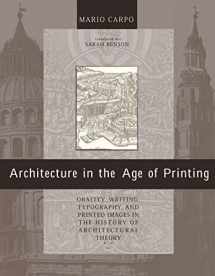
Architecture in the Age of Printing: Orality, Writing, Typography, and Printed Images in the History of Architectural Theory (Mit Press)
ISBN-13:
9780262534093
ISBN-10:
0262534096
Edition:
Reprint
Author:
Mario Carpo
Publication date:
2017
Publisher:
MIT Press
Format:
Paperback
254 pages
Category:
History
,
Architecture
FREE US shipping
Book details
ISBN-13:
9780262534093
ISBN-10:
0262534096
Edition:
Reprint
Author:
Mario Carpo
Publication date:
2017
Publisher:
MIT Press
Format:
Paperback
254 pages
Category:
History
,
Architecture
Summary
Architecture in the Age of Printing: Orality, Writing, Typography, and Printed Images in the History of Architectural Theory (Mit Press) (ISBN-13: 9780262534093 and ISBN-10: 0262534096), written by authors
Mario Carpo, was published by MIT Press in 2017.
With an overall rating of 3.5 stars, it's a notable title among other
History
(Architecture) books. You can easily purchase or rent Architecture in the Age of Printing: Orality, Writing, Typography, and Printed Images in the History of Architectural Theory (Mit Press) (Paperback) from BooksRun,
along with many other new and used
History
books
and textbooks.
And, if you're looking to sell your copy, our current buyback offer is $5.75.
Description
A history of the influence of communication technologies on Western architectural theory.The discipline of architecture depends on the transmission in space and time of accumulated experiences, concepts, rules, and models. From the invention of the alphabet to the development of ASCII code for electronic communication, the process of recording and transmitting this body of knowledge has reflected the dominant information technologies of each period. In this book Mario Carpo discusses the communications media used by Western architects, from classical antiquity to modern classicism, showing how each medium related to specific forms of architectural thinking.Carpo highlights the significance of the invention of movable type and mechanically reproduced images. He argues that Renaissance architectural theory, particularly the system of the five architectural orders, was consciously developed in response to the formats and potential of the new printed media. Carpo contrasts architecture in the age of printing with what preceded it: Vitruvian theory and the manuscript format, oral transmission in the Middle Ages, and the fifteenth-century transition from script to print. He also suggests that the basic principles of "typographic" architecture thrived in the Western world as long as print remained our main information technology. The shift from printed to digital representations, he points out, will again alter the course of architecture.


We would LOVE it if you could help us and other readers by reviewing the book
Book review

Congratulations! We have received your book review.
{user}
{createdAt}
by {truncated_author}


